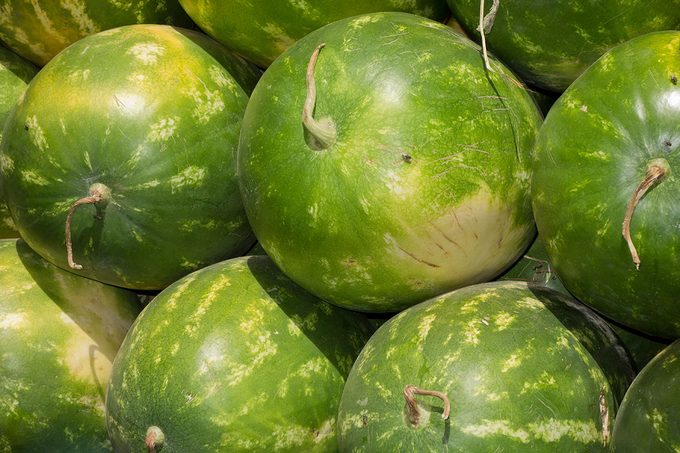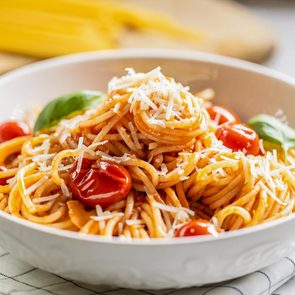Should you scoop it up or steer clear?

Here’s What It Means If You See a White Spot on Your Watermelon

Like apples in the fall or hot chocolate in the winter, watermelon is synonymous with summer. It doesn’t matter if you’re a child or an adult—no one can turn down a red, juicy triangle of watermelon on a hot, sunny day.
But before you can have that ultimate summer moment, you need to pick the right watermelon. It will mean the difference between smiles at the perfect, crisp bite and disappointment at a mealy, mushy mess. Blech! Needless to say, there’s some pressure involved in selecting that watermelon, whether you just want to have healthy snacks on hand or feed an army at a barbecue.
However, nature decided to make things difficult by forcing us to pick based on the outside of the watermelon alone. We’re talking various shades of green, different shapes, weird webbing and, of course, white spots. What does it mean when you see a big, ol’ white spot on your watermelon? Is it a bad omen about what’s inside, or do the specifics of the spot matter?
We asked a watermelon expert to find out everything you need to know about those white spots—and how to pick the perfect watermelon every time.
Get Reader’s Digest’s Read Up newsletter for more helpful tips, humor, travel, tech, cleaning and fun facts all week long.
What does a white spot on a watermelon mean?
Every watermelon is going to have one spot that isn’t green like the rest of the melon. In most cases, it’s white … and nothing to worry about. “A creamy white splotch on a melon’s ‘belly’ is just the field spot—the patch that napped on the soil—so it’s always on the underside,” explains plant expert Tammy Sons, founder and CEO of TN Nursery in Altamont, Tennessee. “And because the fruit rests in one place, you’ll see only one.”
While it’s totally normal for a watermelon to have one white field spot, you may want to bypass any melons that have a very pale or very small white spot. These are both signals that the melon may have been picked too early, which means it won’t have much flavor.
Are white spots on a watermelon ever dangerous?
A normal white field spot will be pretty large, and there will be only one. If there are multiple white spots and they’re smaller than the field spot, stay away. “Skip melons sporting grayish, sunken or mold-flecked wounds,” says Sons. “Those aren’t field spots but rot signals that spell mushy disappointment.”
The texture of a white spot is key here. Even though it’s not green like the rest of the rind, the field spot will feel just as firm and smooth as the rest of the watermelon. If you find white or gray spots that are soft or squishy, that indicates there could be mold or fungus growing on the watermelon. Definitely a no-go!
What do other spots and patterns on a watermelon mean?

In addition to the field spot, there are some other spots and patterns that may appear on a watermelon. Here’s what you need to know.
- Yellow field spot = yum! The white field spot will turn yellow if it spends more time on the vine, so a yellow spot means a tasty melon.
- Orange field spot = buy it now! “If the field patch has ripened from white to a rich, buttery yellow or even pumpkin-orange, do a happy dance,” says Sons. “Extra days on the vine let sugars concentrate, so orange means candy-sweet flesh.”
- Fine, pale webbing = no worries. “The tan ‘webbing’ (those crazy squiggles) forms where pollination scarred the rind,” explains Sons. “A few fine threads are normal.”
- Large, dark webbing = super sweet. A little bit of fine webbing means that the watermelon blossom was pollinated a normal amount before the fruit began to grow. But if you see more webbing, Sons says, it means the blossom was over-fertilized, leading to the growth of a very sweet, high-sugar watermelon.
- Shiny, light green skin = skip it. “Shiny, pale green skin screams I was picked too early!'” Sons says.
- Matte, dark green skin = peak flavor. Grab this watermelon if you see it—it’s at its max flavor, according to Sons, and is the tastiest melon in the pile.
- Round and heavy = juicy and sweet. A watermelon with a symmetrical, round shape that feels heavier than it should be for its size is going to be juicy and delicious.
- Oblong and light = watery and bland. If a melon is light—especially if it’s large and long—it likely won’t have much flavor.
How to pick the perfect watermelon
Here is Sons’s tried-and-true strategy for selecting the perfect watermelon when you’re at the grocery store or the farmers market this summer.
- Check the field spot. Flip the watermelon so its bottom faces you, and look for a buttery yellow or orange field spot.
- Scan the rind. You’ll want a watermelon with a rich dark green, matte finish and spider-web scribbles.
- Give it a thump near the middle. A ripe melon booms back with a bassy “thwunk,” not a dull thud or a tinny ping.
- Lift and compare. Heft two watermelons of similar size—the heavier one packs more juice.
- Scan the stem. A clean, slightly shriveled nub means it released naturally when ripe, while a green, moist stem suggests an early yank.
And there you have it! Happy snacking!
RELATED:
- Here’s Why Some Bananas Are Blue—And What You Need to Know About This Weirdly Colored Fruit
- Here’s Why Some Bananas Are Red—and What You Need to Know About This Weirdly Colored Fruit
- If You See White Stuff Coming Out of Your Chicken, This Is What It Means
About the expert
|
Why trust us
At Reader’s Digest, we’re committed to producing high-quality content by writers with expertise and experience in their field in consultation with relevant, qualified experts. We rely on reputable primary sources, including government and professional organizations and academic institutions as well as our writers’ personal experiences where appropriate. We verify all facts and data, back them with credible sourcing and revisit them over time to ensure they remain accurate and up to date. Read more about our team, our contributors and our editorial policies.
Source:
- Tammy Sons, founder and CEO of TN Nursery; interviewed, June 2025



